Coma Berenices, or Berenice’s Hair, is a constellation in the northern sky. It was named after the Queen Berenice II of Egypt. The constellation is home to the North Galactic Pole.
The Greek astronomer Ptolemy considered Coma Berenices to be an asterism in the constellation Leo, representing the tuft at the end of the lion’s tail, and it was not until the 16th century that Berenice’s Hair was promoted to a constellation in its own right, on a celestial globe by the cartographer Caspar Vopel. It is the Danish astronomer Tycho Brahe who is usually credited for the promotion. He included Coma Berenices among the constellations listed in his star catalogue of 1602.
Coma Berenices is not a large constellation, yet it contains a number of famous deep sky objects, among them the Black Eye Galaxy (Messier 64), Messier 98, Messier 99, Messier 100, the globular cluster Messier 53, the Needle Galaxy (NGC 4565), the Mice Galaxies and other galaxies in the Coma Cluster. It also contains the northern part of the Virgo cluster of galaxies.
Facts, location and map
Coma Berenices is the 42nd constellation in size, occupying an area of 386 square degrees. It lies in the third quadrant of the northern hemisphere (NQ3) and can be seen at latitudes between +90° and -70°. The neighboring constellations are Boötes, Canes Venatici, Leo, Ursa Major, and Virgo.
The constellation name Coma Berenices is pronounced /ˈkoʊmə bɛrəˈnaɪsiːz/. In English, the constellation is known as Berenice’s Hair. The genitive form of Coma Berenices, used in star names, is Comae Berenices (pronunciation: /ˈkoʊmiː bɛrəˈnaɪsiːz/). The three-letter abbreviation, adopted by the International Astronomical Union (IAU) in 1922, is Com.
Coma Berenices belongs to the Ursa Major family of constellations, along with Boötes, Camelopardalis, Canes Venatici, Corona Borealis, Draco, Leo Minor, Lynx, Ursa Major and Ursa Minor.
Coma Berenices has two stars with known planets and contains eight Messier objects: M53 (NGC 5024), the Black Eye Galaxy (M64, NGC 4826), M85 (NGC 4382), M88 (NGC 4501), M91 (NGC 4548), M98 (NGC 4192), M99 (NGC 4254), and M100 (NGC 4321). The brightest star in the constellation is Beta Comae Berenices. There is one meteor shower associated with the constellation; the Coma Berenicids.
Coma Berenices contains two formally named stars. The star names approved by the International Astronomical Union (IAU) are Diadem (Alpha Comae Berenices A) and Phyllon Kissinou (23 Comae Berenices A).
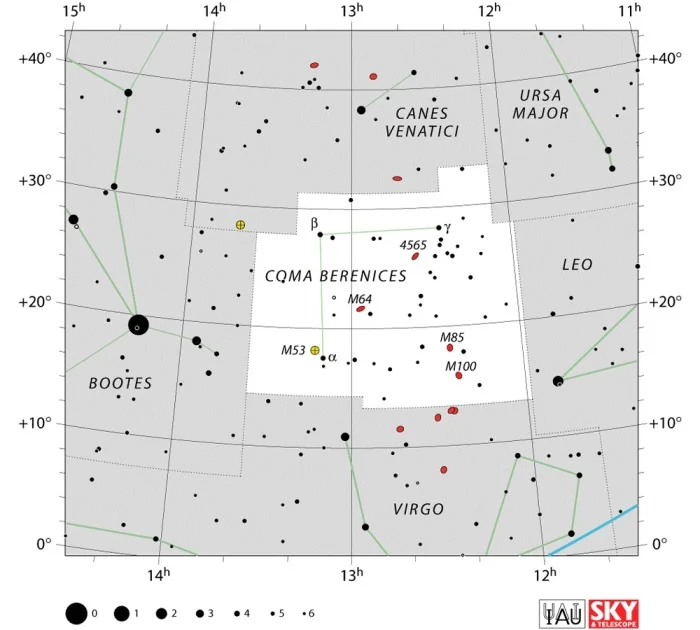
Coma Berenices constellation map by IAU and Sky&Telescope magazine
Coma Berenices myth
Coma Berenices is associated with the story of a historical figure, Queen Berenice II of Egypt. Berenice was married to Ptolemy III Euergetes (fl. 246 BC-221 BC), who went on a dangerous mission against the Seleucids in 243 BC, during the Third Syrian War.
Worried for her husband’s life, the queen swore to Aphrodite that she would cut off her beautiful long, blonde hair if the goddess brought Ptolemy back home safely.
Once her husband returned, Berenice fulfilled her promise to the goddess. She cut off her hair and placed it in Aphrodite’s temple. The hair disappeared the next day. This made the king furious. To appease him, the court astronomer Conon said that Aphrodite was so pleased with Berenice’s offering that she had placed it in the sky, pointing to the group of stars that have since been known as Berenice’s Hair.
Coma Berenices stars
Diadem – α Comae Berenices (Alpha Comae Berenices)
Diadem is the second brightest star in Coma Berenices, with an apparent magnitude of 4.32. It represents the gem in Queen Berenice’s crown. The word itself is derived from the Greek διάδημα (diádēma), which means “band” or “fillet.”
Diadem is a binary star composed of two stars belonging to the spectral class F5V, with magnitudes of 5.05 and 5.08. The system is approximately 63 light years distant. The two stars appear nearly edge-on, as if they were moving back and forth in a straight line, separated at most by only 0.7 arc seconds.
Alpha Comae Berenices is sometimes known by its other traditional name, Al Zafirah, from the Arabic word for “the braid.”
β Comae Berenices (Beta Comae Berenices)
Beta Comae Berenices is the brightest star in the constellation, despite the beta designation, with an apparent magnitude of 4.26. It is a main sequence dwarf star, 29.78 light years distant from the solar system. It is similar to the Sun, only slightly larger and brighter. No planets have yet been discovered in its orbit.
γ Comae Berenices (Gamma Comae Berenices)
Gamma Comae Berenices is a giant star belonging to the spectral class K1II. It has an apparent magnitude of 4.350 and is approximately 170 light years distant.
FK Comae Berenices
FK Comae Berenices is a variable star with an apparent magnitude that varies between 8.14 and 8.33 over a period of 2.4 days. It serves as the prototype for an entire class of variable stars, the FK Com class. These stars are believed to be variable as a result of having large cold spots on their rotating surfaces.
FK Comae Berenices belongs to the spectral class G5II and lies approximately 800 light years from Earth.
Phyllon Kissinou – 23 Comae Berenices
23 Comae Berenices is a binary star system located about 310 light-years away. It has a combined apparent magnitude of 4.80. The individual components shine at magnitudes 4.96 and 6.90. They have an orbital period of 33.04 years.
The system has the stellar classification A0IV, indicating a blue-white subgiant star. The primary component has an estimated age of 210 million years. It has a mass of 2.15 solar masses and a radius three times that of the Sun. With a surface temperature of 9,675 K, it shines with 104 solar luminosities.
In 2024, the International Astronomical Union (IAU) approved the name Phyllon Kissinou for the primary component. The name comes from the Greek phrase φύλλοv κισσίνου (phyllon kissinou) and refers to an ivy leaf. It is mentioned in Ptolemy’s Almagest.
Deep sky objects in Coma Berenices
Black Eye Galaxy – Messier 64 (M64, NGC 4826)
The Black Eye Galaxy (Messier 64) is a spiral galaxy with an apparent magnitude of 9.36, lying approximately 24 million light years from Earth. It is sometimes also called the Sleeping Beauty Galaxy or Evil Eye Galaxy.
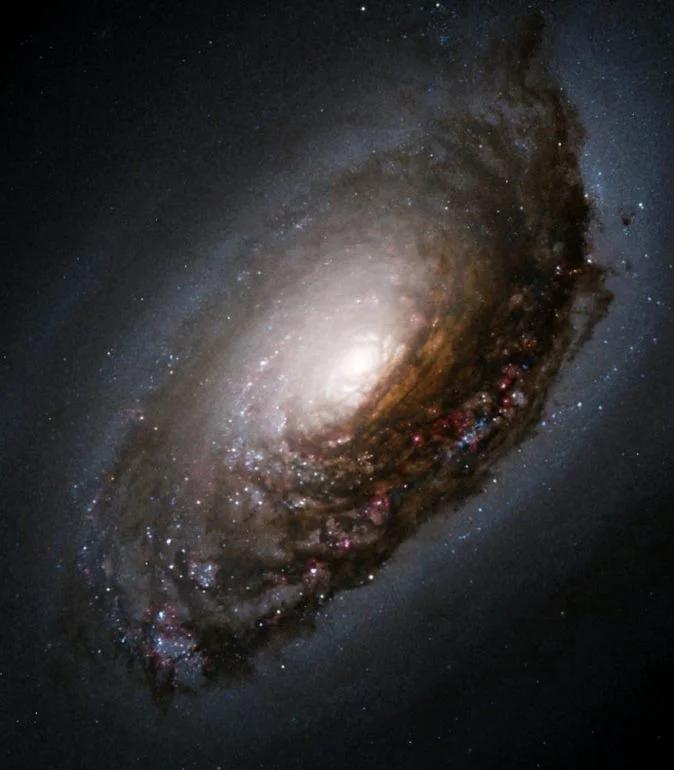
This image of Messier 64 (M64) was taken with Hubble’s Wide Field Planetary Camera 2 (WFPC2). The color image is a composite prepared by the Hubble Heritage Team from pictures taken through four different color filters. These filters isolate blue and near-infrared light, along with red light emitted by hydrogen atoms and green light from Strömgren y. M64 has a spectacular dark band of absorbing dust in front of the galaxy’s bright nucleus, giving rise to its nicknames of the Black Eye or Evil Eye galaxy. At first glance, M64 appears to be a fairly normal pinwheel-shaped spiral galaxy. As in the majority of galaxies, all of the stars in M64 are rotating in the same direction, clockwise as seen in the Hubble image. However, detailed studies in the 1990’s led to the remarkable discovery that the interstellar gas in the outer regions of M64 rotates in the opposite direction from the gas and stars in the inner regions. Active formation of new stars is occurring in the shear region where the oppositely rotating gases collide, are compressed, and contract. Particularly noticeable in the image are hot, blue young stars that have just formed, along with pink clouds of glowing hydrogen gas that fluoresce when exposed to ultraviolet light from newly formed stars. Astronomers believe that the oppositely rotating gas arose when M64 absorbed a satellite galaxy that collided with it, perhaps more than one billion years ago. This small galaxy has now been almost completely destroyed, but signs of the collision persist in the backward motion of gas at the outer edge of M64. Image: NASA and The Hubble Heritage Team (AURA/STScI)
It is a popular object among amateur astronomers, as it can be easily observed in small telescopes. The Black Eye Galaxy has a bright nucleus and a dark band of dust in front of it, which earned it the nickname the Evil Eye.
The galaxy is an unusual one; the gas in its outer regions rotates in the opposite direction from the stars and gas in its inner regions. Astronomers speculate that this could be a result of M64 having absorbed a smaller satellite galaxy about a billion years ago.
The inner region spans only 3,000 light years in radius, while the outer parts extend to another 40,000 light years. The region separating the two is a site of active star formation.
M64 was independently discovered by Edward Pigott and Johann Elert Bode in 1779, and then by Charles Messier, who included the galaxy in his catalogue in 1780.
The Black Eye can be found one degree east-northeast of the star 35 Comae Berenices.
Needle Galaxy (NGC 4565)
The Needle Galaxy is one of the most famous edge-on spiral galaxies in the sky. It was discovered by Sir William Herschel in 1785. The galaxy can be seen in a small telescope. It lies exactly above the North Galactic Pole, a degree east of the star 17 Comae.
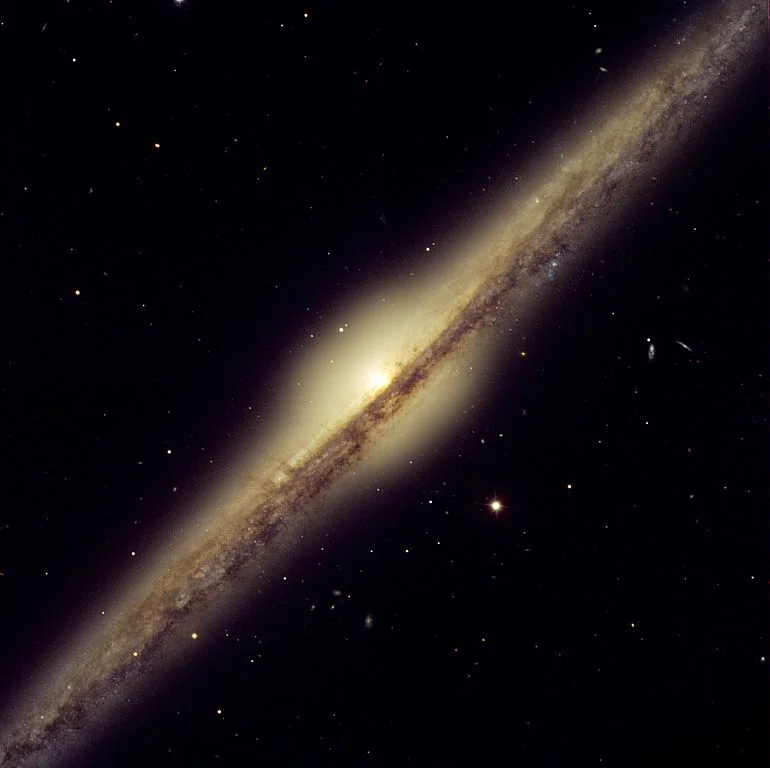
The galaxy pictured here is NGC 4565, which for obvious reasons is also called the Needle Galaxy. First spotted in 1785 by Uranus’ discoverer, Sir William Herschel (1738-1822), this is one of the most famous example of an edge-on spiral galaxy and is located some 30 million light-years away in the constellation Coma Berenices (Berenice’s Hair). It displays a bright yellowish central bulge that juts out above most impressive dust lanes. Because it is relatively close (it is only 12 times farther away than Messier 31, the Andromeda galaxy, which is the major galaxy closest to us) and relatively large (roughly one third larger than the Milky Way), it does not fit entirely into the field of view of the FORS instrument (about 7 x 7 arcmin2). Many background galaxies are also visible in this FORS image, giving full meaning to their nickname of “island universes”. Image: ESO
The galaxy has an apparent magnitude of 10.42 and is approximately 42.7 million light years distant.
Based on the shape of the central bulge, astronomers believe that NGC 4565 is a barred spiral galaxy. Being 16 arc minutes in length, it has the largest apparent length of any edge-on galaxy discovered.
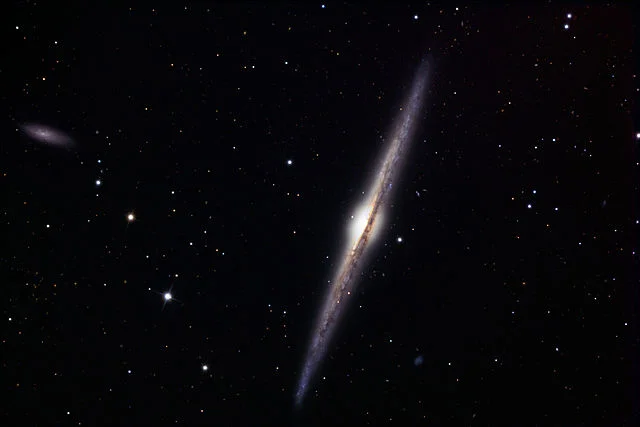
NGC 4565 and NGC 4562, image: Wikimedia Commons/ Jschulman555 (CC BY 3.0)
Coma Star Cluster (Melotte 111)
The Coma Star Cluster is a small star cluster with about 40 bright stars of magnitudes between 5 and 10. The stars in the cluster share a common proper motion.
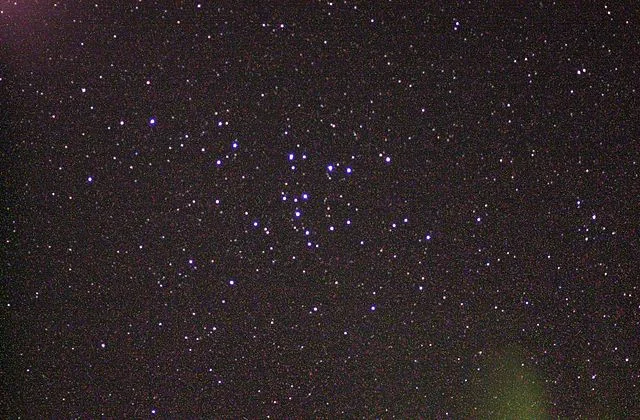
The Coma Star Cluster, a collection of stars which are visible to the unaided eye in the constellation Coma Berenices, is visible in this view photographed by astronaut Donald R. Pettit, Expedition Six NASA ISS science officer, on board the International Space Station (ISS). The Coma Cluster is visible as a faint fuzzy patch between the constellations Leo and Virgo. The unaided eye cannot resolve the individual stars, but collectively, they merge into a fuzzy flow in this part of the sky. Image: NASA/Donald R. Pettit
The cluster was catalogued by P.J. Melotte. It spans over 7.5 degrees in the sky. It is believed to be around 450 million years old and lies approximately 280 light years from Earth.
Coma Cluster of galaxies
The Coma Cluster of galaxies lies north of the Virgo Cluster, but is significantly more remote, between 230 and 300 million light years from the solar system.
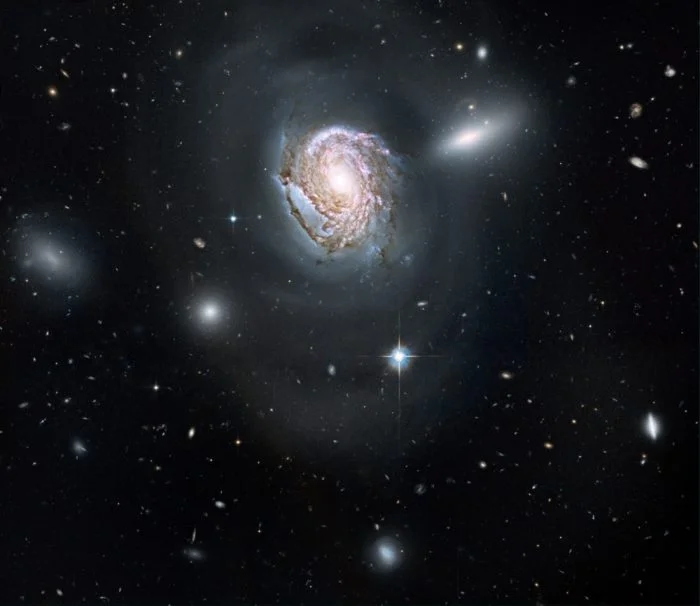
A long-exposure Hubble Space Telescope image shows a majestic face-on spiral galaxy located deep within the Coma Cluster of galaxies, which lies 320 million light-years away in the northern constellation Coma Berenices. The galaxy, known as NGC 4911, contains rich lanes of dust and gas near its center. These are silhouetted against glowing newborn star clusters and iridescent pink clouds of hydrogen, the existence of which indicates ongoing star formation. Hubble has also captured the outer spiral arms of NGC 4911, along with thousands of other galaxies of varying sizes. The high resolution of Hubble’s cameras, paired with considerably long exposures, made it possible to observe these faint details. NGC 4911 and other spirals near the center of the cluster are being transformed by the gravitational tug of their neighbors. In the case of NGC 4911, wispy arcs of the galaxy’s outer spiral arms are being pulled and distorted by forces from a companion galaxy (NGC 4911A), to the upper right. The resultant stripped material will eventually be dispersed throughout the core of the Coma Cluster, where it will fuel the intergalactic populations of stars and star clusters. The Coma Cluster is home to almost 1,000 galaxies, making it one of the densest collections of galaxies in the nearby universe. It continues to transform galaxies at the present epoch, due to the interactions of close-proximity galaxy systems within the dense cluster. Vigorous star formation is triggered in such collisions. Galaxies in this cluster are so densely packed that they undergo frequent interactions and collisions. When galaxies of nearly equal masses merge, they form elliptical galaxies. Merging is more likely to occur in the center of the cluster where the density of galaxies is higher, giving rise to more elliptical galaxies. Image: NASA, ESA, and the Hubble Heritage Team (STScI/AURA)
The Coma Cluster contains about 1,000 large galaxies and 30,000 smaller ones, a great majority of them brighter than 19.0. The brightest galaxies in the group are of thirteenth magnitude. They are NGC 4889 and NGC 4874. Another notable member is NGC 4921, one of the comparatively few spirals in the group and the brightest spiral galaxy in the cluster.
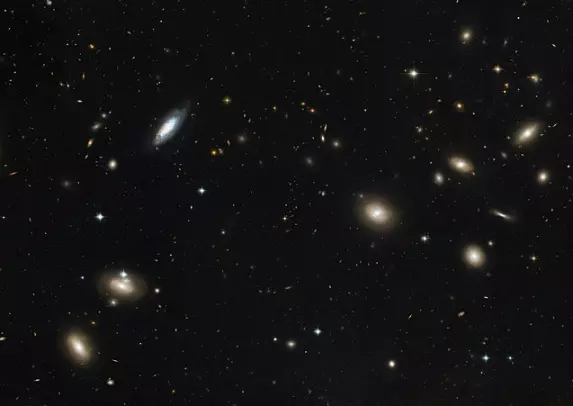
Hubble’s Advanced Camera for Surveys has viewed a large portion of the Coma Cluster, stretching across several million light-years across. The entire spherical cluster is more than 20 million light-years in diameter and contains thousands of galaxies. Most of the galaxies that inhabit the central portion of the Coma Cluster are elliptical galaxies. These featureless “fuzz-balls” are a pale golden brown in colour and contain populations of old stars. Both dwarf and giant ellipticals are found in abundance in the Coma Cluster Image: NASA, ESA, and the Hubble Heritage Team (STScI/AURA). Acknowledgment: D. Carter (Liverpool John Moores University) and the Coma HST ACS Treasury Team.
Virgo Cluster of galaxies
The constellation Coma Berenices contains the northern part of the Virgo Cluster of galaxies, sometimes called the Coma-Virgo Cluster. The cluster is located roughly 60 million light years from Earth.
The galaxies that fall into this group are Messier 100, Messier 85, Messier 99, Messier 88 and Messier 91.
Messier 53 (M53, NGC 5024)
Messier 53 is a globular cluster located approximately 58,000 light years from Earth and 60,000 light years from the Galactic Centre.
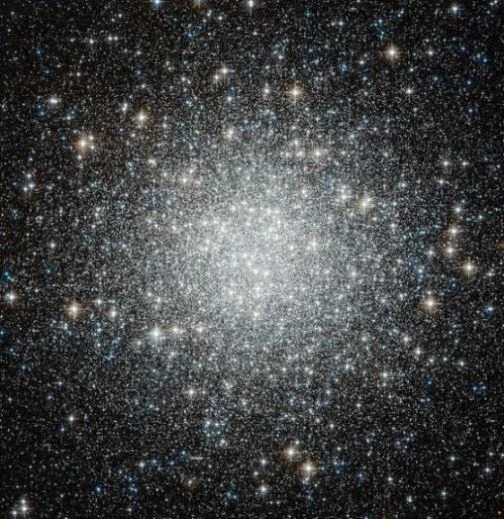
Thousands and thousands of brilliant stars make up this globular cluster, Messier 53, captured with crystal clarity in this image from the NASA/ESA Hubble Space Telescope. Bound tightly by gravity, the cluster is roughly spherical and becomes denser towards its heart. These enormous sparkling spheres are by no means rare, and over 150 exist in the Milky Way alone, including Messier 53. It lies on the outer edges of the galaxy, where many other globular clusters are found, almost equally distant from both the centre of our galaxy and the Sun. Although they are relatively common, the famous astronomer William Herschel, not at all known for his poetic nature, once described a globular cluster as “one of the most beautiful objects I remember to have seen in the heavens”, and it is clear to see why. Globular clusters are much older and larger than open clusters, meaning they are generally expected to contain more old red stars and fewer massive blue stars. But Messier 53 has surprised astronomers with its unusual number of a type of star called blue stragglers. These youngsters are rebelling against the theory of stellar evolution. All the stars in a globular cluster are expected to form around the same time, so they are expected follow a specific trend set by the age of the cluster and based on their mass. But blue stragglers don’t follow that rule; they appear to be brighter and more youthful than they have any right to be. Although their precise nature remains mysterious these unusual objects are probably formed by close encounters, possibly collisions, between stars in the crowded centres of globular clusters. This picture was put together from visible and infrared exposures taken with the Wide Field Channel of Hubble’s Advanced Camera for Surveys.The field of view is approximately 3.4 arcminutes across. Image: ESA/Hubble & NASA
Round in shape and with a very bright centre, the cluster was discovered by Johann Elert Bode in 1775 and then independently by Charles Messier two years later. It is one of the more distant globular clusters known. It has an apparent magnitude of 8.33. The stars in the cluster are mostly metal-poor.
M53 can be found a degree northeast of the star Alpha Comae Berenices. It is the brightest Messier object in the constellation. It can be seen with binoculars.
Messier 100 (M100, NGC 4321)
Messier 100 is a grand design spiral galaxy in Coma Berenices. It has a brilliant core, two main spiral arms and a number of less prominent ones, as well as a few dust lanes. The galaxy lies in the Virgo cluster and is one of the brightest member galaxies in it. It also has the largest apparent size, seven arc minutes across.
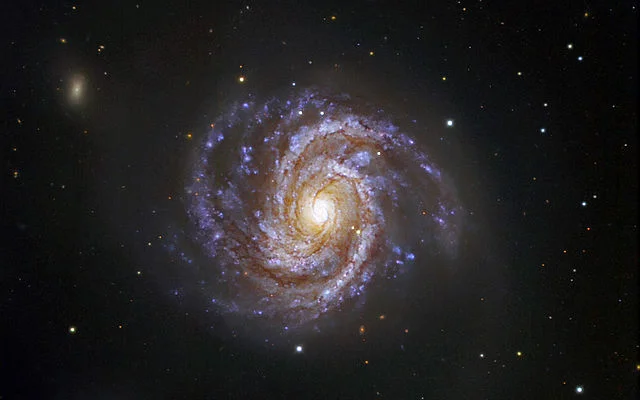
Similar in appearance to our own Milky Way, Messier 100 is a grand spiral galaxy that presents an intricate structure, with a bright core and two prominent arms. The galaxy harbours numerous young and hot massive stars as well as exceptionally hot regions of ionised hydrogen. Two smaller arms are seen emerging from the centre and reaching towards the larger spiral arms. The galaxy, located 60 million light-years away, is slightly larger than the Milky Way, with a diameter of about 120,000 light-years. A supernova was discovered in M100 on 4 February 2006. Named SN 2006X, it is the 5th supernova to have been found in M100 since 1900. This image is based on data acquired with the 1.5 m Danish telescope at the ESO La Silla Observatory in Chile, through three filters (B: 1390 s, V: 480 s, R: 245 s). The supernova is the brighter of the two stars seen just to the lower right of the galaxy centre. Image: ESO/IDA/Danish 1.5 m/R. Gendler, J.-E. Ovaldsen, C. C. Thöne and C. Féron
Messier 100 is about 160,000 light years in diameter and approximately 55 million light years distant. It has an apparent magnitude of 10.1. It was discovered by Pierre Méchain on March 15, 1781. It was one of the first spiral galaxies ever discovered.
Five supernovae have been observed in the galaxy.
M100 contains a satellite galaxy, NGC 4323, which is about 52.5 million light years distant and has an apparent magnitude of 15.7.
Messier 85 (M85, NGC 4382)
Messier 85 is a lenticular galaxy in Coma Berenices. It is one of the most distant Messier objects, lying approximately 60 million light years away.
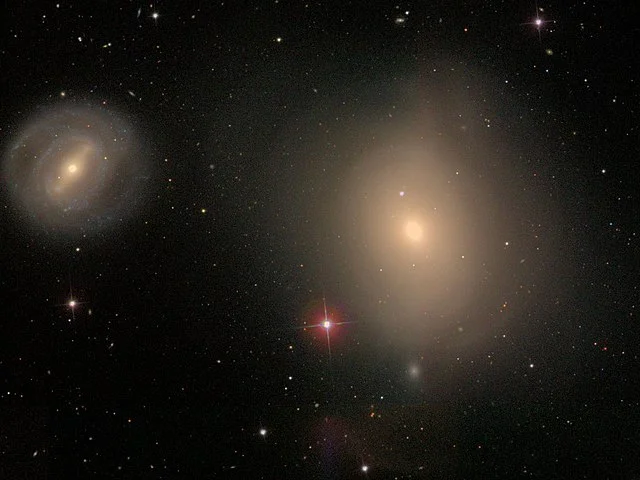
The Messier 85 lenticular galaxy on the right and the NGC 4394 SBb barred spiral galaxy on the left. Image: SDSS/Giuseppe Donatiello (CC0 1.0)
M85 is about 125,000 light years in diameter and has an apparent magnitude of 10.0. The galaxy was discovered by Pierre Méchain in 1781. It is the northernmost member of the Virgo cluster of galaxies. A supernova was discovered in M85 in December 1960.
The galaxy is interacting with two smaller neighbours; the spiral galaxy 4394 and elliptical galaxy MCG 3-32-38.
Messier 99 (M99, NGC 4254)
Messier 99 is an unbarred spiral galaxy with an apparent magnitude of 10.4, approximately 50.2 million light years distant. It was discovered by Pierre Méchain in 1781 and subsequently included in the Messier catalogue by Charles Messier. Three supernovae have been observed in the galaxy.
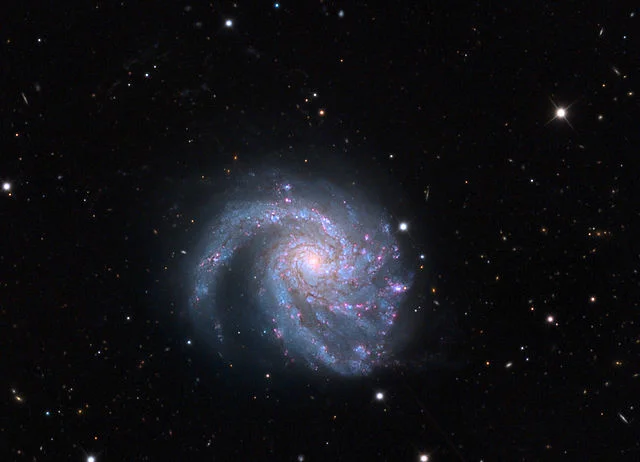
Messier 99, image: Adam Block/Mount Lemmon SkyCenter/University of Arizona (CC BY-SA 3.0 US)
M99 is believed to have been distorted by the nearby possible dark galaxy VIRGOHI21, to which it appears to be linked by a bridge of neutral hydrogen gas.
Messier 88 (M88, NGC 4501)
Messier 88 is a spiral galaxy, discovered by Charles Messier in Coma Berenices in 1781.
It has an apparent magnitude of 10.4 and is approximately 47 million light years distant. It is classified as a type 2 Seyfert galaxy; it produces narrow spectral line emissions from highly ionized gas in its nucleus.
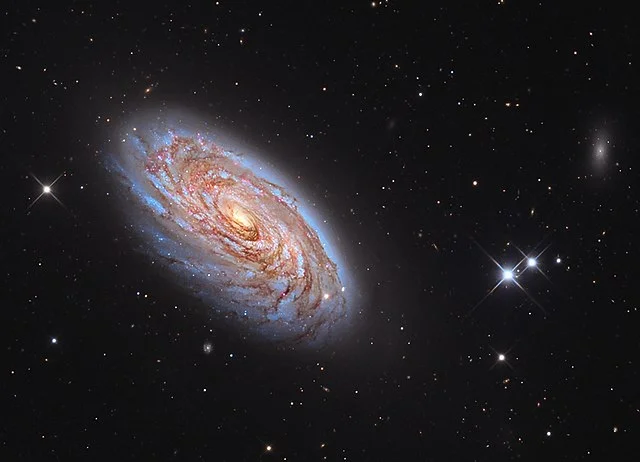
Messier 88, image: Adam Block/Mount Lemmon SkyCenter/University of Arizona (CC BY-SA 3.0 US)
The galaxy has multiple spiral arms and a supermassive black hole in its centre, one that has 80 million times the mass of the Sun.
M88 is one of the 15 Messier objects that lie in the Virgo Cluster of galaxies. A supernova was observed in the galaxy in 1999.
Messier 91 (M91, NGC 4548)
Messier 91 is a barred spiral galaxy that also belongs to the Virgo Cluster. It was discovered by Charles Messier in 1781. It has an apparent magnitude of 11.0 and is approximately 63 million light years distant.
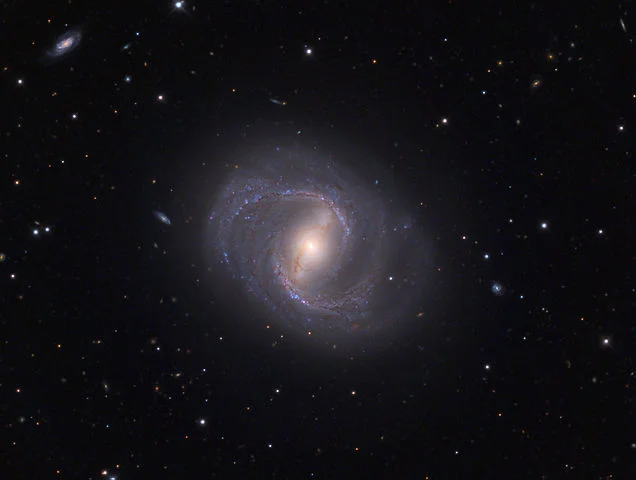
Adam Block/Mount Lemmon SkyCenter/University of Arizona (CC BY-SA 4.0)
Messier 98 (M98, NGC 4192)
Messier 98 is an intermediate, elongated spiral galaxy with an apparent magnitude of 11.0. It appears almost edge-on. It has a small core and large, faint spiral arms.
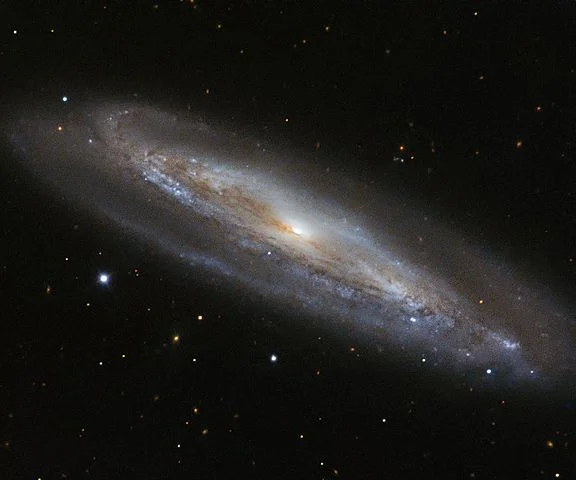
The colour blue has many associations — coldness, sadness, serenity. However, the colour holds a completely different meaning for astronomers, as demonstrated by the edge-on spiral galaxy Messier 98. Messier 98, also known as NGC 4192, is located approximately 50 million light-years away in the constellation of Coma Berenices (Berenice’s Hair). In this spectacular image from ESO’s New Technology Telescope (NTT), the galaxy’s perimeter, rippled with gas and dust, is dotted with pockets of blueish light. These are regions filled with very young stars, which are so hot that they glow with a bright blue hue. These young stars are burning at such high temperatures that they are emitting fierce radiation, burning away some of the dense material that surrounds them. In total, Messier 98 is thought to contain one trillion stars! Image: ESO, acknowledgement: Flickr user jbarring
M98 is located half a degree west of the star 6 Comae, or one and a half degrees west-northwest of Messier 99.
The galaxy lies approximately 54.1 million light years from Earth. It was first observed by Pierre Méchain in 1781 and catalogued by Charles Messier the same year.
M98 is located within the Virgo Cluster.
NGC 4889 (Caldwell 35)
NGC 4889 is a supergiant elliptical galaxy located in the Coma Cluster. It has an apparent magnitude of 11.4 and is approximately 308 million light years distant. The galaxy can be found in the vicinity of the star Beta Comae Berenices.
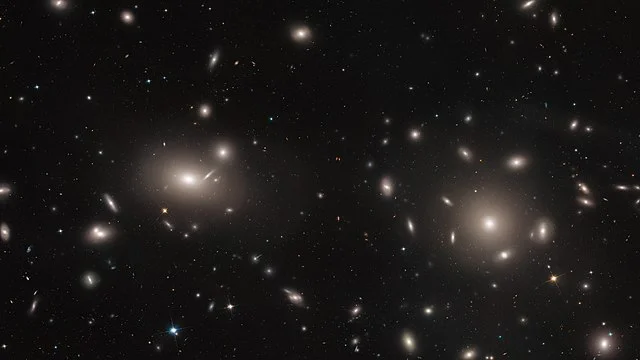
This image, from the NASA/ESA Hubble Space Telescope’s Advanced Camera for Surveys (ACS), reveals thousands of globular clusters lying at the core of a galaxy cluster. It was created by a Hubble survey that drew on data from three of the telescope’s separate observing programmes to explore the centre of the Coma cluster, a huge gathering of over 1000 galaxies, about 320 million light-years away, all bound together by gravity. Astronomers spotted over 22 000 globular clusters, some of which had formed a bridge connecting a pair of well-known interacting galaxies (NGC 4889 and NGC 4874). A globular cluster is a spherical group of stars that usually orbits a galaxy as a self-contained satellite. However, the globular clusters studied here are of a different type, intracluster globular clusters. Specifically, these are globular clusters that are not bound to an individual galaxy, but to a galaxy cluster — in this case, Coma. While globular clusters orbiting our Milky Way reveal themselves as sparkling spherical assemblies of densely packed stars, at the distance of the Comla cluster, they only appear as tiny dots of light, even to Hubble’s advanced vision. However, a characteristic feature of globular clusters is their colour; since the stars in any given cluster all formed at around the same time and from the same “stuff”, they usually have a consistent colour. In this way, the astronomers were able to identify the clusters — and rule out background galaxies lying in the same region of sky — by analysing their colour and size, painting a beautiful family portrait of Coma and its clusters. With the help of the identified globular clusters astronomers can map the distribution of matter and — even more important — of dark matter in the Coma cluster. The Coma Cluster was one of the first places where observed gravitational anomalies indicated the existence of dark matter. Image: NASA, ESA, J. Mack, and J. Madrid et al.
NGC 4147
NGC 4147 is a small, relatively faint globular cluster with an apparent magnitude of 10.2. It appears diffuse in smaller telescopes, but larger ones reveal a bright cluster, round in shape, without a brighter, well-defined core.